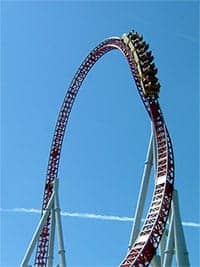Last year I joined in a 1 year investing contest with 20 other personal finance bloggers called the “Grow Your Dough Throwdown 2.0“, sponsored by one of my favorite investing sites, Motif Investing.
The idea behind the contest was for all 20 contestants to start with $500, invest the money, and then see who could garner the greatest returns over a 1 year period.
There were a variety of investing ideas put to the test during the contest. Some folks put all their money into diversified index funds, aiming to earn the market returns over the year. Others put their money into one or two individual stocks hoping to pick winners, while still others invested in big ideas or industries they felt would do well over the year.
Quick Navigation
Diversifying My Holdings
To start the contest I decided I was going to invest in a wide range of stocks, 25-30 dividend stocks. The stocks came from multiple industries that had high dividends, no history of cutting dividends and stocks that had been trending positively.
My strategy was to hopefully see some nice gains in the stocks since they had all been trending positively, and to see some additional gains due to dividends that were paid on the stocks.
The only problem was that while the stocks started out decently, when the market turned south a bit, so did my portfolio. I went from gains of 2-3% to showing some losses of 2% for the year.
Since the contest was such a short term contest, only for 1 year, I knew I needed to change strategies.
Normally when investing for the long term I may have invested in a highly diversified index fund portfolio that would show solid returns for the long term, with a lower amount of risk.
Since the contest was so short I knew I needed to take a gamble and try to pick a couple of individual stocks that had good potential for big upside.
Picking Individual Stocks With Good Upside
When I changed strategies in May, when the contest was almost half over, there was one person who had taken a huge lead in the contest. Phil from PTMoney.com had a 286% increase on his initial investment of $500, with no one else even in the same ballpark.
I looked at what strategy he had taken in the contest, in hopes that I would be able to emulate his success. Here is what he suggested doing:
- Check the “Top Signals Stocks” at BarChart.com for a stock that is showing good positive momentum, and that was listed as a 100% buy.
- After identifying 3 or 4 good possibilities at the top of the list, do further research on the stocks to narrow it down further.
- Choose a stock that looks like it has the best possibility for big gains in the short term.
After doing a day of research, I chose to buy stock from Sarepta Therapeutics Inc (SRPT), a biopharmaceutical company from: top10pharma.net
The company was listed as a big buy in many spots because of a positive meeting they just had with the FDA in regards to the approval of their new drug to treat Muscular Dystrophy.
I ended up buying 17.5 shares of SRPT stock at $24.60, and almost immediately I saw the stock price start to rise. I made $40 within that first day!
Buying Individual Stocks Can Be Addicting, Especially When You’re Doing Well
I watched as my stock started to go up, and continued going up over the coming months.
It went from $24.60 to $30, then $35. By the time I wrote my September update it had risen all the way to $37.89 – a gain of 53.7%!
My portfolio as a whole was up over 41% in the contest. Not too shabby, right? It was enough to put me near the top of the leaderboard, in 2nd place. In first place was PT with a whopping 415.6% gain on his initial investment!
When reward is at its pinnacle, risk is near at hand. – John C. Bogle
Seeing my gains of 53.7% on my main stock was addicting, making me want to dabble in individual stocks even more. I mean, hey, if I can make 50% on my money in this short of a time frame, and PT can make over 400% on his money over the year, think of just how much money could be made just by doing a small amount of research over a longer time period.
By the time the contest ended on December 31st, the stock had ended the year at $38.58 – for a gain of 56% or so.
While I didn’t win the contest, my appetite for individual stock investing was increased immensely.
It wouldn’t last.
The Bottom Drops Out On My Stock: The Roller Coaster Ride Begins

On January 15th the bottom dropped out on Sarepta. While the stock price had dropped by a couple of dollars since the new year (as had the market in general), on the 15th Sarepta received some negative news from the FDA about approval of their drug. The news was disastrous for the company as many of their hopes were pinned on getting approval for the drug.
In one night the stock price dropped from over $30 per share, all the way down to $15 per share. And it didn’t stop dropping. It dropped to as low as about $10 or so I believe.
I went from having a gain of around 50% on the stock, to a loss of about 60%! That’s quite the roller coaster ride!
Investing In Individual Stocks Is Inherently More Risky
For most of this year I’ve watched the SRPT stock linger around the $15-20 mark, putting me in the red for the time that I’ve carried the stock.
While the stock is doing a bit better in the past month due to some positive news they’ve received in regards to a trial drug approval, it only surpassed the price at which I bought it, this week. Today as I wrote this article, it surpassed $27 for the first time in a long time!
UPDATE 9/9/16: The SRPT stock jumped in price to over $53 a share today (9/19/16) on the news that Sarepta’s drug, Exondys 51, which treats Duchenne muscular dystrophy has been given accelerated approval. So for now the investment seems to have paid dividends again with a gain of over 115%!
UPDATE 10/19/16: The SRPT stock got as high as $63.73 at the end of September, before leveling out and coming back to earth. By the time I sold the SRPT stock on 10/18/16, SRPT was back to around $50/share. So I received about a 103% return on my initial investment. That’s not too shabby.
While I’m glad that I haven’t lost money on this stock at this point (and in fact done quite well), the roller coaster ride only underpins what for me is the most important point in investing in individual stocks.
Don’t look for the needle in the haystack. Just buy the haystack! – John C. Bogle
While individual stocks may be able to give you greater gains than many diversified mutual funds in the short term, (especially if you stay on top of things as far as researching your stock picks, staying on top of news, etc), they can also carry with them the risk of greater losses.
You never know when an individual company is going to go belly up, have a poor earnings report or have a drug denied approval by the FDA. Individual stocks are a roller coaster ride, and on many of them you never know for sure quite where they’ll end up.
For me this experiment in individual stock picking has confirmed that for me the best route to go is investing for the long term via well diversified index funds. I don’t have the time or the inclination to pay close enough attention to individual stocks in order to get the best returns. Studies have shown that active stock picking and actively managed mutual funds don’t do better than index funds over the long term anyway.
Get Started Today For The Long Term
Looking to get started in a sensible index fund investment today? If you’re more of a hands off type investor, I’d recommend a robo-advisor like one of the following services:
If you are looking to keep your costs even lower and you don’t mind staying a bit more involved, I’d recommend a 3 fund portfolio via a company like Vanguard:
Have your own crazy experiences investing in individual stocks? Tell us about your roller coaster ride in the comments!




Peter Lynch, one of the biggest guru investors of all time, swore by a di ersified portfolio of high-risk stocks. While his investment horizon was short to midterm, it, (his strategy) could apply to short-term investments, (like those in the contest you describe.
To paraphrase his own description:
If you invest in a diversified portfolio of 10 high-risk stocks, on average, nine of them will tank, losing half their value. You lose $4.50 on a $9.00 investment, but, with skill and luck, you’re tenth pick will be the elusive “ten-bagger,” (stock that increases twn-fold during your investment window.). It’s ten-fold increase means if will rise from $1.00 a share, to $10.00 per share, more than offsetting your $4.50 loss and far exceeding the returns on index funds and conventionally-managed funds.
The particular stratagems he used go pick his stocks has little application in today’s market, but the theory strikes me as a sound one.